I have to confess that my love of asteroids started in film, namely the (admittedly ridiculous) asteroid chase in The Empire Strikes Back. It was solidified by the gloriously melodramatic film Meteor and its shots of the asteroid hurtling towards Earth with the booming “it’s going to kill everyone!” music that played every time it was on screen. I suppose these are why I always smile when an asteroid pops up in the science-fiction I read, which thankfully, has many more imaginative uses for them.
2312 by Kim Stanley Robinson
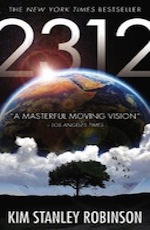 This novel contains so many concepts to fall in love with, but the idea of terrarium asteroids is my favourite (with sunwalkers a close second!). Robinson writes of a future in which asteroids are hollowed out, and biomes created within, with their own gravity thanks to the rotation of the asteroid. Some are created to preserve delicate ecologies that are no longer sustainable on Earth, some to provide beautiful and exciting environments to visit for holidays or even live in. This use of asteroids is featured in his novel Blue Mars, but in 2312 they have become an art form for the protagonist, Swan Er Hong, a way to express herself as well as serving a need to preserve rare species. I love the idea of hundreds of these asteroids in space, all rocky and unassuming on the outside, but each its own jewel within.
This novel contains so many concepts to fall in love with, but the idea of terrarium asteroids is my favourite (with sunwalkers a close second!). Robinson writes of a future in which asteroids are hollowed out, and biomes created within, with their own gravity thanks to the rotation of the asteroid. Some are created to preserve delicate ecologies that are no longer sustainable on Earth, some to provide beautiful and exciting environments to visit for holidays or even live in. This use of asteroids is featured in his novel Blue Mars, but in 2312 they have become an art form for the protagonist, Swan Er Hong, a way to express herself as well as serving a need to preserve rare species. I love the idea of hundreds of these asteroids in space, all rocky and unassuming on the outside, but each its own jewel within.
The Sparrow by Mary Doria Russell
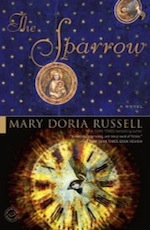 The Sparrow is a beautiful and heart rending novel which tells a first contact tale in flashbacks as we follow the slow, painful recovery of a Jesuit priest who is the only person to return from a mission to a planet called Rakhat. After detecting a form of music coming from the planet via the SETI project, a crew is formed to go and make contact. Their craft is made from an asteroid mostly hollowed out already by a mining company extracting minerals. I love the idea of using what is considered waste material, sticking an engine on it and hurtling across space inside it.
The Sparrow is a beautiful and heart rending novel which tells a first contact tale in flashbacks as we follow the slow, painful recovery of a Jesuit priest who is the only person to return from a mission to a planet called Rakhat. After detecting a form of music coming from the planet via the SETI project, a crew is formed to go and make contact. Their craft is made from an asteroid mostly hollowed out already by a mining company extracting minerals. I love the idea of using what is considered waste material, sticking an engine on it and hurtling across space inside it.
Eon by Greg Bear
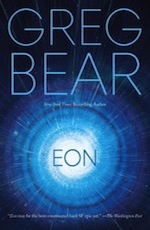 Like many books published in the mid 80’s, the Cold War and the omnipresent threat of nuclear war are both an inspiration and theme in this novel. The Berlin Wall was still very much in place and Bear envisages a near future where the Cold War still rages between the superpowers. Then a massive asteroid appears on the edge of the solar system and moves into orbit and, of course, the superpowers race to understand and claim it. My favourite use of the asteroid in this novel is contained within the seventh chamber which forms The Way, effectively a portal to other dimensions. What’s not to love about that?
Like many books published in the mid 80’s, the Cold War and the omnipresent threat of nuclear war are both an inspiration and theme in this novel. The Berlin Wall was still very much in place and Bear envisages a near future where the Cold War still rages between the superpowers. Then a massive asteroid appears on the edge of the solar system and moves into orbit and, of course, the superpowers race to understand and claim it. My favourite use of the asteroid in this novel is contained within the seventh chamber which forms The Way, effectively a portal to other dimensions. What’s not to love about that?
Titan by Stephen Baxter
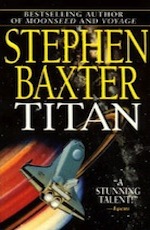 In Titan, Baxter writes of a future which takes America down a just-plausible-enough-to-be-terrifying path of religious extremism and intellectual degradation. It has a fundamentalist Christian President who rules over an isolated country that now teaches its children that the Earth is at the centre of the solar system. This climate of anti-science makes it all the harder for a team of scientists to go and investigate the potential of life on Titan, but after various set-backs and awful events, they manage to get there. In this novel, (spoilers ahead!) an asteroid is used by the Chinese in retaliation for attacks from the US but their plan to merely threaten with it backfires, and it smashes into Earth causing catastrophic damage. Whilst this is a horrific use of an asteroid, I do have a morbid fondness for extinction event stories (thanks Meteor).
In Titan, Baxter writes of a future which takes America down a just-plausible-enough-to-be-terrifying path of religious extremism and intellectual degradation. It has a fundamentalist Christian President who rules over an isolated country that now teaches its children that the Earth is at the centre of the solar system. This climate of anti-science makes it all the harder for a team of scientists to go and investigate the potential of life on Titan, but after various set-backs and awful events, they manage to get there. In this novel, (spoilers ahead!) an asteroid is used by the Chinese in retaliation for attacks from the US but their plan to merely threaten with it backfires, and it smashes into Earth causing catastrophic damage. Whilst this is a horrific use of an asteroid, I do have a morbid fondness for extinction event stories (thanks Meteor).
The Kraken Wakes by John Wyndham
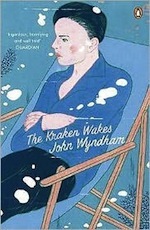 Okay, you have to give me a pass for this one because it features meteors, rather than asteroids, but it’s one of my favourite novels and I love the way they are used as a starting point in this ‘cosy catastrophe’ novel. At the beginning of the book, the protagonist and his wife are on the deck of a ship, watching several meteors plummet into the ocean. Of course, the meteors turn out to be an alien invasion. It’s the slow build of the threat this novel which makes it so deliciously tense. Many overlook this novel for the other “meteor shower begins cosy catastrophe” by Wyndham; ‘The Day of the Triffids’, but I urge you to give this one a try if you haven’t already.
Okay, you have to give me a pass for this one because it features meteors, rather than asteroids, but it’s one of my favourite novels and I love the way they are used as a starting point in this ‘cosy catastrophe’ novel. At the beginning of the book, the protagonist and his wife are on the deck of a ship, watching several meteors plummet into the ocean. Of course, the meteors turn out to be an alien invasion. It’s the slow build of the threat this novel which makes it so deliciously tense. Many overlook this novel for the other “meteor shower begins cosy catastrophe” by Wyndham; ‘The Day of the Triffids’, but I urge you to give this one a try if you haven’t already.
This post originally ran October 29, 2015.
 Emma Newman writes dark short stories and science fiction and urban fantasy novels. Between Two Thorns, the first book in Emma’s Split Worlds urban fantasy series, was shortlisted for the BFS Best Novel and Best Newcomer awards. Her novels Planetfall—a scifi narrative about a secret withheld to protect humanity’s future—and After Atlas are available now from Roc. Emma is an audiobook narrator and also co-writes and hosts the Hugo-nominated podcast ‘Tea and Jeopardy’ which involves tea, cake, mild peril and singing chickens. Her hobbies include dressmaking and playing RPGs.
Emma Newman writes dark short stories and science fiction and urban fantasy novels. Between Two Thorns, the first book in Emma’s Split Worlds urban fantasy series, was shortlisted for the BFS Best Novel and Best Newcomer awards. Her novels Planetfall—a scifi narrative about a secret withheld to protect humanity’s future—and After Atlas are available now from Roc. Emma is an audiobook narrator and also co-writes and hosts the Hugo-nominated podcast ‘Tea and Jeopardy’ which involves tea, cake, mild peril and singing chickens. Her hobbies include dressmaking and playing RPGs.










Admittedly ridiculous???
I don’t know that I’ve ever heard anybody call the ESB asteroid chase ridiculous. It’s one of my favorite scenes (and favorite music, and even contributes some of the best quotes) in the movie! The AOTC asteroid/ring chase is pretty good (I really love Ben Burtt’s sound design and the sonic charges) but still not as good as the ESB scene.
@1: It’s a great scene but the asteroids are much closer to each other than they would be in a real asteroid belt (if they were that close, gravity would pull them together as one): from Scientific American, there’s about a five million kilometre separation between the kind of “sizeable” asteroids which would make suitable homes for space slugs, which is an order of magnitude greater than the Earth-Moon distance. The hard part of crossing our asteroid belt is telling whether you are in it: it’s very easy, for example, to send space probes through our asteroid belt without loss or damage.
See also Bruce Sterling’s Schismatrix, John McLoughlin’s The Helix and the Sword, and L.Neil Smith’s The Venus Belt (all asteroids with internal habitats). Sterling’s especially notices that machinery goes wrong, and people are very untidy……
@1 Lisamarie: I know, right? Also love everything about that scene. But sadly, @2 is right. It is ridiculous. I found that out only recently, and am still getting over it (mostly by writing these ridiculously dense asteroid fields into all my fanfic…).
I also like stories with hollow asteroids. There was at least one in Star Trek and at least one in classic Doctor Who. But I just finished a book about a prison inside of an asteroid (and escaping from it, well, at least talking about an escape…) and it was not very good.
@2 oh, okay, I’ll give you that :)
Where is the fun in having an asteroid under your control if you don’t use it to destroy planet Earth?
@@.-@: If you like, I can keep the “stop having fun guys” trope going by pointing out issues with hollowed asteroids as well…
@5: It also isn’t entirely clear how the “sonic” charge in AOTC is supposed to propagate through such a rarefied medium but perhaps I am paying too much attention to the science content of a film series whose main characters are samurai space wizards. (I know, it’s a strange choice of hill to die on…)
One of my favourite pulp novels – first published in 1952 – was by Blake Savage and called Ride the Gray Planet, a thinly-veiled Cold War competition between the Federation of Free Governments and the evil Consops (‘the Connies’ – no allusions there!). Lieutenant Rip Foster and a squad of Planeteers were detailed to land on an asteroid of pure thorium, blast it out of the Asteroid Belt, and blast it to head for Earth. There`s fairly liberal use of atomic explosives and a pair of comedy ship commanders, one French and the other Scottish. Not exactly highbrow literature, but enough to get a preteen hooked on science fiction.
Rendezvous With Rama. As it’s basically the inspiration for Eon (which is also excellent), surely this must be on the list.
Admittedly the enjoyable but inferior sequels obey the law of diminishing returns, but the original is a classic.
I’m sure there’s a way to justify the SW-style asteroid belts given that there isn’t vacuum in space in SW. I’d assume that the same aether-style space atmosphere that allows for sound transmission through space, atmospheric flight characteristics of space ships in space, giant, inertia-filled capital ships coming to a halt in space simply by turning off their main drives, life forms that swim through space, sonic/concussion weapons that work in space, and all the other things of that sort, would also be able to explain how an asteroid belt could maintain extreme density without collapsing into a planet or other singular body.
As far as I’m concerned, one innocuous asteroid narrative towers above the rest: “Oh No, Astro!” by Matt Roeser (illustrated by Brad Woodard). Look it up – you won’t be disappointed.